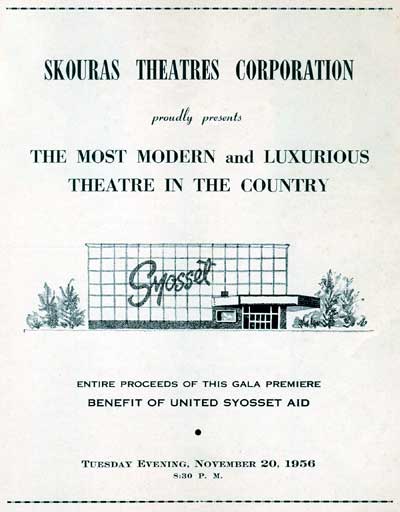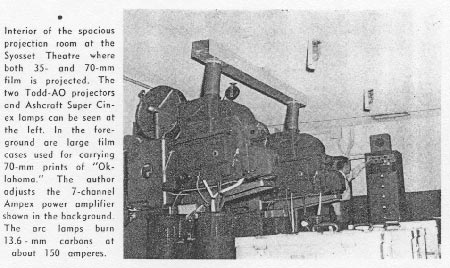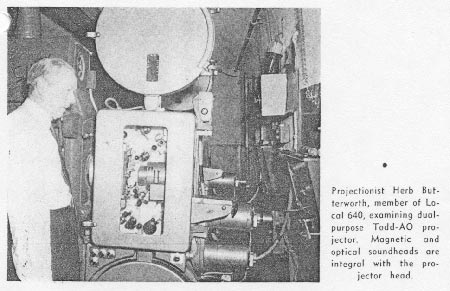Cinerama & Todd-AO at The Syosset |
Read more
at in70mm.com The 70mm Newsletter |
| Written by: Joe Kelly | Date: November 14, 2003 |
|
|
Further
in 70mm reading: The Passing of Joe Kelly DP70 / Universal 70-35 / Norelco AAII - The Todd-AO Projector in70mm.com's Cinerama page The Todd-AO Saga Internet link: Also read: International Projectionist, January 1957, page 11 and 12. |
 The screen frame had an adjustable curvature to accommodate the Todd AO specified deep chord depth while permitting 35mm Flat and Scope wide screen formats to form lesser chord depths. The full screen chord width was 56 feet and 25 feet high, with motorized top and side masking borders. The picture sheet was approx. 65 feet wide. A motorized contoured austral shade curtain covered the screen and rose majestically at the beginning of the movie. The screen frame had an adjustable curvature to accommodate the Todd AO specified deep chord depth while permitting 35mm Flat and Scope wide screen formats to form lesser chord depths. The full screen chord width was 56 feet and 25 feet high, with motorized top and side masking borders. The picture sheet was approx. 65 feet wide. A motorized contoured austral shade curtain covered the screen and rose majestically at the beginning of the movie. The entire front end equipment was set on a contoured concrete stage platform and equipped with an attractive set of risers in front that ended at the stage chord line. This permitted a generous set back of forward seating not seen in modern theatres now. The sound system was an Ampex 6 Channel multi-purpose system with 30 watt vacuum tube amplifiers, requiring little power to drive the large Altec A-4X horn loaded screen speaker systems. Surrounds consisted of 12" diameter paper cone speakers in wall baffles on the side and rear walls and sunk into the ceiling under the mezzanine. The length of theatre at 150 feet and small balcony/mezzanine created a rather shallow projection angle of about 4 degrees down, minimizing keystone artefacts. |
|
Cinerama Introduced |
|
 Sometime in 1960 (my best guess) Cinerama came to Long Island and the Syosset was selected as it appeared from an engineering point of view that the installation would not impact
unfavourably to the theatre Sometime in 1960 (my best guess) Cinerama came to Long Island and the Syosset was selected as it appeared from an engineering point of view that the installation would not impact
unfavourably to the theatre The massive 30 ft radius 146 degree louvered Cinerama screen was positioned in front of Todd AO screen and erected with patent scaffolding from Chesbro-Whitman company in Long Island City with special Cinerama specified hardware to attach the louver boards. Cinerama supplied their own Altec A-4 speaker systems placed in the scaffold bays with double vertically stacked high frequency horns splayed to provide a wide horizontal dispersion angle. They also supplied their own surround speakers which were large Altec 2 way A-7 type horn systems placed in special wall mounted cabinets hung on the side and back walls of the theatre. A new added front traveller type curtain and track was hung off the screen frame and installed with 3 phase motor and controls, and supplied by Cinerama, typical with their installations. Two small projection booths were cut into the side walls of the theatre with entrances off the front of the mezzanine; thus providing the “Able”, & “Charlie” projection sources. The center screen “Baker” projector was set in the main booth and required the removal of one of the Phillips projectors which were jockeyed with Johnson Bars and muscle to a store room on the west side of the main projection area. This was the most involved procedure as a lot of projection and sound wiring had to be disconnected , labeled and placed out of the way in a safe manner. This was done under the supervision of an RCA service engineer assigned to the project. The projection port was enlarged and centered to accommodate the Cinerama projector and a carefully selected long throw lens was used to match the image sizes generated by the Able & Charlie projectors. Alignment was rather complex due to the variations in lens focal lengths and projection angles, but a very good image was achieved with very little match line artefacts. The Cinerama operating console was placed at the rear of the main floor seating area for a conductor that adjusted picture sync and switched surround sound between the side and rear walls on specific on screen cues. |
|
CinemaScope on the Curve |
|
 The theatre played the original Cinerama travelogue type programs until August of 1961 when they booked a 35mm Cinemascope film
“La Dolce Vita” and insisted it be played on the Cinerama screen since other Cinerama film playdates followed. This was done on an overnight tour to remove the Cinerama “Baker” projector and re-install the Phillips Norelco projector in the spot it once had, changing lens focal lengths and cutting new “bow tie” aperture plates. Needless to say, I was not at all happy with the assignment, or the results. The theatre played the original Cinerama travelogue type programs until August of 1961 when they booked a 35mm Cinemascope film
“La Dolce Vita” and insisted it be played on the Cinerama screen since other Cinerama film playdates followed. This was done on an overnight tour to remove the Cinerama “Baker” projector and re-install the Phillips Norelco projector in the spot it once had, changing lens focal lengths and cutting new “bow tie” aperture plates. Needless to say, I was not at all happy with the assignment, or the results. After a short run of “La Dolce Vita” they booked in “The Longest Day” and I was now part of company management. I decided to place a smaller curved Cinemascope screen sandwiched inside of the Cinerama screen, the frame was custom built in Pittsburg to my specifications and drawings. It contained four scaffold uprights forming three 9 ft wide bays with wing extensions on each side to set into the Cinerama screen radius at the 40 foot chord line. Three smaller Altec A-5x horn loaded speaker systems were installed on platforms in the bays, as we played the film in 4 track magnetic stereo. This presentation was free of the curvilinear distortion that we had with “La Dolce Vita” due to the longer radius of the new inserted screen. The picture size of 40 foot width placed within the Cinerama screen and closer to the audience provided good viewer participation with this great wartime classic. The excellent 4 track magnetic recording mix was well worth the price of admission. The screen and frame was removed after that run and discarded. |
|
Cinerama and Cinerama 70 at the same time |
|
 The Cinerama equipment was finally removed in 1962 to make way for the Long Island premier of
“West Side Story” which although filmed in 65mm Panavision it was shown on the Todd AO screen with the original lenses. Before the opening of
“West Side Story” the original Ampex sound racks were removed from the east side wall and relocated on the back wall of the booth with all components replaced with a new high level switching system and new Ampex 60 watt power amplifiers. The Cinerama equipment was finally removed in 1962 to make way for the Long Island premier of
“West Side Story” which although filmed in 65mm Panavision it was shown on the Todd AO screen with the original lenses. Before the opening of
“West Side Story” the original Ampex sound racks were removed from the east side wall and relocated on the back wall of the booth with all components replaced with a new high level switching system and new Ampex 60 watt power amplifiers.3-strip Cinerama came back to Syosset later that year for run of “The Wonderful World of the Brothers Grimm” and followed by “How The West Was Won” The equipment was updated with the elimination of the conductors console and improved electronics for sound and picture sync. Cinerama engineers agreed with my suggestion to utilize the new Ampex 60 watt amplifiers instead of installing their own. This involved a stage and surround horn switching panel which we built in our shop. Cinerama’s 6 track full coat mag. Dubber was patched into the remote input of the Ampex 6 channel fader. Since the conductor’s console was eliminated surround sound for these two films was mono. During the run of “The Wonderful World of the Brothers Grimm” I knew I would eventually be faced with ramifications of replacing Cinerama’s “Baker” projector with the Phillips Norelco projector and decided to create a new spot for the Phillips projector since the projection room was large enough. I ordered a new port to be cut into the booth front wall next to the Cinerama “Baker” port and installed the Phillips projector in that spot. We ran new wiring from the rectifier DC switching panel to the projector, bypassing the old wiring in the floor box under the Cinerama projector, plus new AC power and control wiring with changeover interfaces. The 6/4 track Phillips mag head and optical sound wiring was rerouted to a junction box on the booth front wall to pick-up a new cable to the preamp rack on the back wall. The alteration paid off with the introduction of 70mm single strip Cinerama during the run of “How The West Was Won” and a press preview scheduled for “It's A Mad Mad Mad World” The Syosset was the only theatre available in the New York Metro area that could play both 3 strip and single strip Cinerama 70 at the same time. The rest of that story appears in another issue of the “IN 70 MM” web site. |
|
70mm, Dolby Stereo and Closure |
|
 “It's A Mad
Mad Mad World” followed “How The West Was Won” when we then added an additional attraction, placing speakers in the rest rooms to pick-up the surround track during the Act 2 entract. It certainly startled the ladies when they heard the police calls by Tracy & Demarest that were manually switched in by the projectionists. “It's A Mad
Mad Mad World” followed “How The West Was Won” when we then added an additional attraction, placing speakers in the rest rooms to pick-up the surround track during the Act 2 entract. It certainly startled the ladies when they heard the police calls by Tracy & Demarest that were manually switched in by the projectionists. Cinerama at the Syosset was history after that run. The equipment and screen was removed and we went back to 35/70mm operation on the original Todd AO screen, which was rebuilt with a traveler type curtain track that operated also as a side mask for common height, variable width picture formats. The alterations were completed in time for the premier of Walt Disney’s “Mary Poppins” in 35mm 1.85 format and 4 track magnetic stereo sound, in 1964. The theatre continued with many 70mm programs run at reserved seat, hard ticket sales, until 1983 when it was split up into three auditoriums; 2 on the main floor and 1 in the balcony. An extended floor was built from the front of the mezzanine over the lower auditoriums providing a set back for the screen to improve viewing. The Norelco DP70 projectors were replaced with the newer model AA-2, with 4000 watt xenon lamp systems using only one with an automated platter film handling package, keeping the other one in place as a back-up. A Dolby CP-100 sound processor was installed for SVA optical sound as well as for 6 track magnetic. Xenon equipped Century 35mm projectors with Dolby stereo optical sound was installed in the lower theatres. The theatre closed in 1996 and the building was torn down to accommodate a new and different business |
|
|
Go: back
- top - back issues
- news index Updated 21-01-24 |
|

 Long Island, New York’s prestigious roadshow cinema showplace built in 1956 was designed to accommodate large wide screen projection systems; opening on November 20th 1956 with a gala premier of
Long Island, New York’s prestigious roadshow cinema showplace built in 1956 was designed to accommodate large wide screen projection systems; opening on November 20th 1956 with a gala premier of